7.5: Geothermal Energy
- Page ID
- 69431
Geothermal energy originates from heat rising to the surface from Earth’s molten iron core created during the formation and compression of the early Earth as well as from heat produced continuously by radioactive decay of uranium, thorium, and potassium in the Earth’s crust. Geothermal power plants harness this heat energy to produce electricity much in the same way that heat from burning coal generates energy (figure \(\PageIndex{1-3}\)). Water is injected underground and heated. The steam that emerges can be used directly, the heat can be transferred to closed system of another fluid, which then boils (figure \(\PageIndex{3}\)). Either way, the steam (or other high-pressure gas) ultimately turns a turbine and powers a generator.
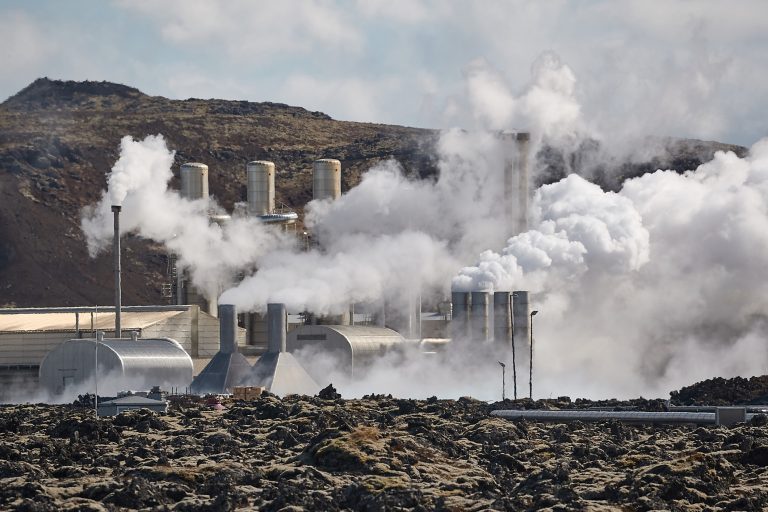
Figure \(\PageIndex{1}\): Steam is released from a geothermal power plant. Image by Open Access Government (CC-BY).
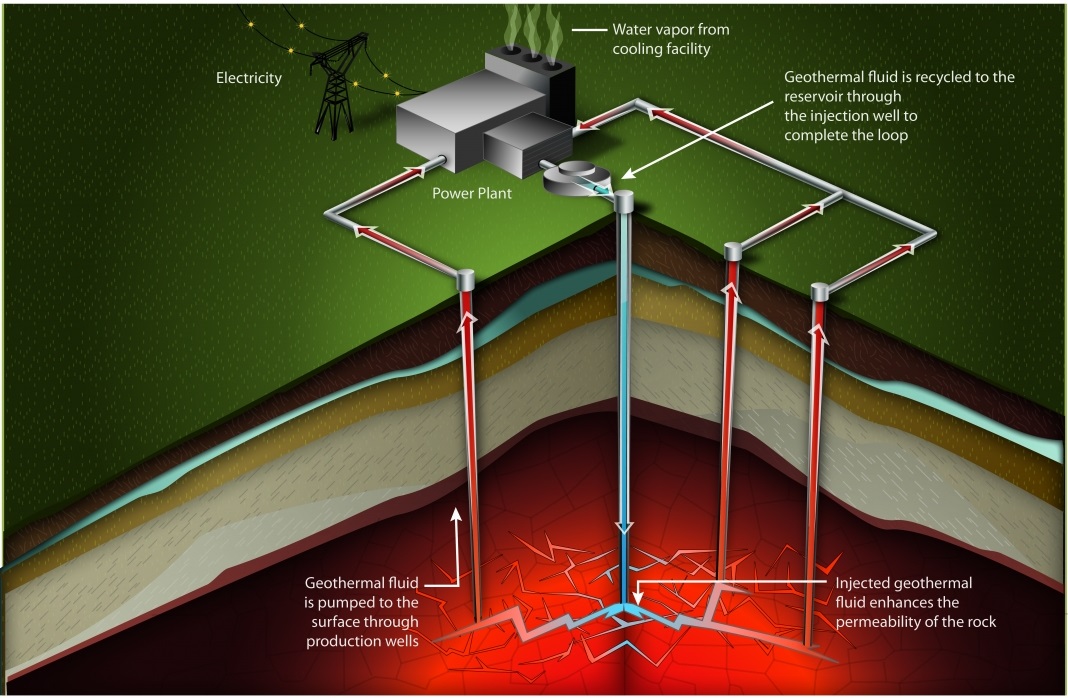
Figure \(\PageIndex{2}\): In a geothermal power plant, geothermal fluid is injected underground. (Geothermal water refers to the hot water/steam used in this process.) It enhances the permeability of the rocks and is heated underground. It exits to the surface through production wells, where it is used to generate electricity in the geothermal power plant. Water vapor is released from the cooling facility of the power plant. To recycle the geothermal fluid, it is returned to the reservoir and injected back into the ground. Image from Office of Energy Efficiency and Renewable Energy/U.S. Department of Energy (public domain).
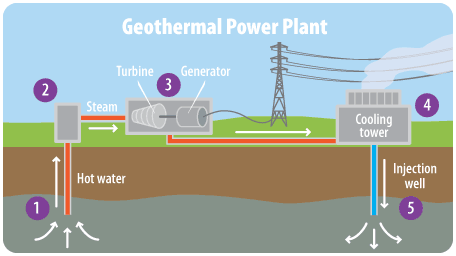
Figure \(\PageIndex{3}\): (1) In a geothermal power plant, hot water is pumped from deep underground through a well under high pressure. (2) When the water reaches the surface, the pressure is dropped, which causes the water to turn into steam. (3) The steam spins a turbine, which is connected to a generator that produces electricity. (4) The steam cools off in a cooling tower and condenses back to water. (5) The cooled water is pumped back into the Earth to begin the process again. Image and caption (modified) from EPA (public domain).
Geothermal heat pumps (ground-source heat pumps) rely on cool temperatures underground to cool or heat homes (figure \(\PageIndex{4}\)). They are sometimes considered a second type of geothermal energy, but they are also a means of energy conservation. Geothermal heat pumps use a heat-exchange system that runs in the subsurface about 20 feet (5 meters) below the surface, which is consistently cool (around 55°F, or 12.5° C). Fluid is pumped underground and then along ducts in the home. This cools the house during the summer, acting as a heat sink. During a cold winter, it warms the house to 55° F (acting as a heat source), and traditional heating systems do the rest. This reduces the energy consumption required to generate heat from gas, steam, hot water, and conventional electric air-conditioning systems.

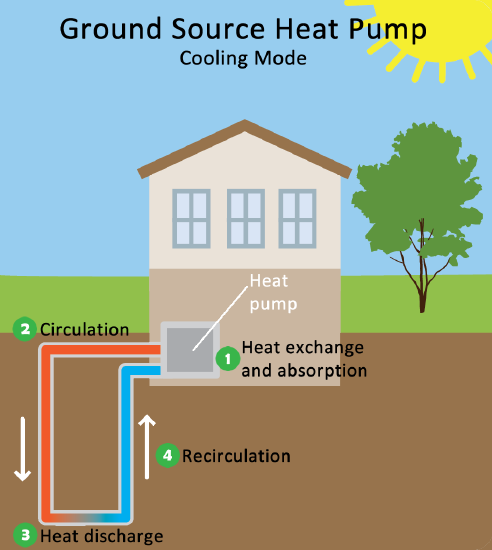
Figure \(\PageIndex{4}\): A ground source heat pump (geothermal heat pump) in heating mode (during the winter; left) and in cooling mode (during the summer; right). There are four steps for heating mode (left). (1) Circulation: The above-ground heat pump moves water or another fluid through a series of buried pipes or ground loops. (2) Heat absorption: As the fluid passes through the ground loop, it absorbs heat from the warmer soil, rock, or ground water around it. (3) Heat exchange and use: The heated fluid returns to the building where it used for space or water heating. The system uses a heat exchanger to transfer heat into the building’s existing air handling, distribution, and ventilation system. (4) Recirculation: Once the fluid transfers its heat to the building, it returns at a lower temperature to the ground loop to be heated again. This process is repeated, moving heat from one point to another. The four steps for cooling mode (right) are similar: (1) heat exchange and absorption, (2) circulation, (3) heat discharge, and (4) recirculation. Images and caption (modified) from EPA (public domain).
This video explains the construction and mechanism of geothermal heat pumps.
Not only does geothermal energy have multiple applications (generating electricity, heating, and cooling), but it is reliable. While solar and wind energy are intermittent, heat is consistently radiated from deep underground. Additionally, the cool temperatures closer to the surface needed for geothermal heat pumps are present year round and at all locations. Geothermal power plants for electricity generation, however, can only be built in specific locations where hot magma is close enough to the Earth's surface. These locations are typically associated with geysers, hot springs, or volcanoes (figure \(\PageIndex{5}\)). Additionally, geothermal power plants are costly to build.
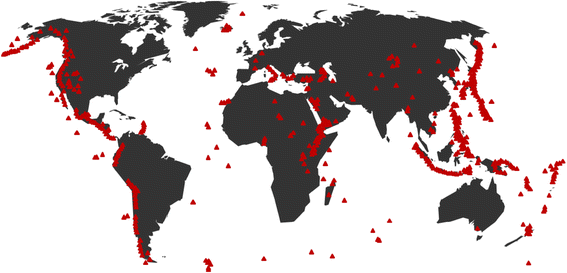
Figure \(\PageIndex{5}\): Locations of the world's volcanoes. They are concentrated along the west coasts of North American and South America as well as just east of Asia and Australia. These regions, which wrap around the Pacific Ocean, form what is known as the Ring of Fire. Image by Salazar, S.S., Muñoz, Y. & Ospino, A. Analysis of geothermal energy as an alternative source for electricity in Colombia. Geotherm Energy 5, 27 (2017). (CC-BY)
The environmental impact of geothermal energy depends on how it is being used. The use of geothermal heat pumps has almost no negative impact on the environment. Geothermal power plants do not burn fuel to generate electricity, so they generate minimal air pollution. They release less than 1% of the carbon dioxide emissions of a fossil fuel plant. Geothermal plants plants use scrubber systems to clean the air of hydrogen sulfide that is naturally found in the steam and hot water. They emit 97% less sulfur compounds (one cause of acid deposition/acid rain) than are emitted by fossil fuel plants. After the steam and water from a geothermal reservoir have been used, they are injected back into the Earth. One environmental concern associated with geothermal power plants is geothermal drilling during their construction has caused earthquakes, similar to the effects of injection wells for fracking.
Attribution
Modified by Kyle Whittinghill and Melissa Ha from the following sources:
- Renewable Energy and Challenges and Impacts of Energy Use from Environmental Biology by Matthew R. Fisher (licensed under CC-BY
- Essentials of Environmental Science by Kamala Doršner is licensed under CC BY 4.0.


